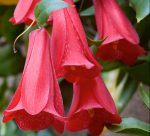 Native to damp coastal woodlands of Chile and Argentina, this twining evergreen vine is a member of the Philesiaceae, a small family endemic to Chile. The plants grow over 30′ tall among shrubs and trees and have leathery lanceolate leaves with 3-5 conspicuous parallel veins. In summer the vines produce pendulous bell-shaped-flowers that are up to 3″ long, rose pink, and pollinated by hummingbirds. The flowers have 6 thick, leathery tepals and give way to elongated fruits with tough skins and containing many small seeds. Numerous cultivars are available that vary in color and floral structure. Although plants are somewhat tender, they can be used outdoors as climbers on trelles and other garden structures in warm climates and in pots and as houseplants elsewhere. The genus name, Lapageria, is from the maiden name of Napoleaon’s wife Empress Josephine, Marie Joséphine Rose Tascher de la Pagerie (1763-1814), an avid plant collector. The specific epithet, rosea, is the Latin word meaing pink.
Native to damp coastal woodlands of Chile and Argentina, this twining evergreen vine is a member of the Philesiaceae, a small family endemic to Chile. The plants grow over 30′ tall among shrubs and trees and have leathery lanceolate leaves with 3-5 conspicuous parallel veins. In summer the vines produce pendulous bell-shaped-flowers that are up to 3″ long, rose pink, and pollinated by hummingbirds. The flowers have 6 thick, leathery tepals and give way to elongated fruits with tough skins and containing many small seeds. Numerous cultivars are available that vary in color and floral structure. Although plants are somewhat tender, they can be used outdoors as climbers on trelles and other garden structures in warm climates and in pots and as houseplants elsewhere. The genus name, Lapageria, is from the maiden name of Napoleaon’s wife Empress Josephine, Marie Joséphine Rose Tascher de la Pagerie (1763-1814), an avid plant collector. The specific epithet, rosea, is the Latin word meaing pink.
Type: Evergreen vine
Bloom: Pendulous red flowers in summer
Size: Up to 30′ tall
Light: Part to full shade
Soil: Average, consistently moist, well-drained, neutral to acidic
Hardiness: Zones 9-11
Care: Prune after flowering when needed.
Pests and Diseases: Aphids, mealybugs, scale insects, tortrix moth
Propagation: Cutting, layering, division, fresh seed of species
Sampling of Outstanding Selections:
L. rosea ‘Albiflora’ (white flowers)
‘Nash Court’ (large red flowers)
‘Puren’ (strong pink flowers)
‘Quelipichum’ (red double flowers)
‘Wisley Spotted’ (white fowers with pink spots)
Photo Credit: 